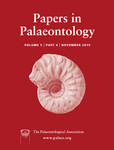Reg. Charity No. 1168330

Cayaoa bruneti, from the early Miocene Gaiman Formation of Chubut, Argentina, provides the earliest evidence for diving behaviour and the earliest example of flight loss within Anseriformes. It is also the only known diving duck from South America. A new phylogenetic analysis using only morphological characters places Cayaoa bruneti as part of a single radiation of diving ducks within Anatinae, as sister group to the Erismaturinae. Partition analysis of subsets of characters shows that the humerus and femur have the strongest effect in generating this phylogeny, while the skull characters result in groupings closer to those seen in analyses with molecular data. When the analysis is constrained by enforcing the molecular tree as a backbone, Cayaoa bruneti emerges as a basal branch within the Erismaturinae. These results make Cayaoa bruneti an independent and early example of the recurring evolution of flightlessness in large marine Anatidae.